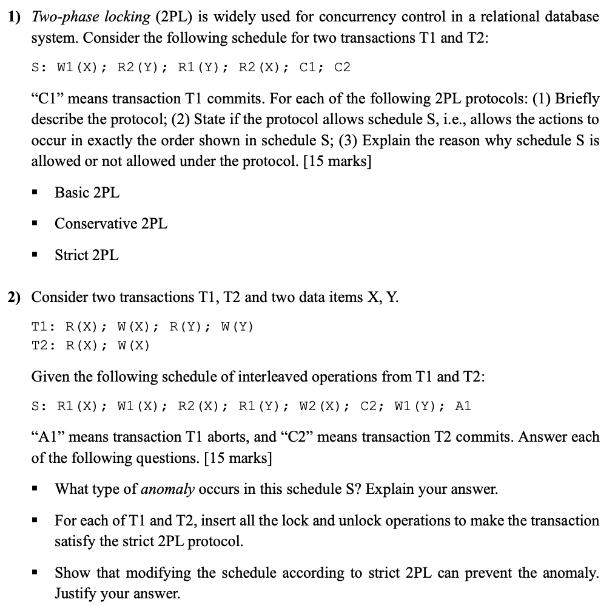Answered step by step
Verified Expert Solution
Question
1 Approved Answer
1) Two-phase locking (2PL) is widely used for concurrency control in a relational database system. Consider the following schedule for two transactions T1 and

1) Two-phase locking (2PL) is widely used for concurrency control in a relational database system. Consider the following schedule for two transactions T1 and T2: S: W1 (X); R2 (Y); R1 (Y); R2 (X); C1; C2 "C1" means transaction T1 commits. For each of the following 2PL protocols: (1) Briefly describe the protocol; (2) State if the protocol allows schedule S, i.e., allows the actions to occur in exactly the order shown in schedule S; (3) Explain the reason why schedule S is allowed or not allowed under the protocol. [15 marks] Basic 2PL Conservative 2PL Strict 2PL 2) Consider two transactions T1, T2 and two data items X, Y. T1: R (X); W (X); R(Y); W (Y) T2: R (X); W (X) Given the following schedule of interleaved operations from T1 and T2: S: R1 (X); W1 (X); R2 (X); R1 (Y); W2 (X); C2; W1 (Y); Al "A1" means transaction T1 aborts, and "C2" means transaction T2 commits. Answer each of the following questions. [15 marks] What type of anomaly occurs in this schedule S? Explain your answer. For each of T1 and T2, insert all the lock and unlock operations to make the transaction satisfy the strict 2PL protocol. Show that modifying the schedule according to strict 2PL can prevent the anomaly. Justify your answer.
Step by Step Solution
★★★★★
3.42 Rating (161 Votes )
There are 3 Steps involved in it
Step: 1
Question 1 TwoPhase Locking 2PL Protocols 1 Basic 2PL Description In Basic 2PL a transaction is divided into two phases the growing phase where locks ...
Get Instant Access to Expert-Tailored Solutions
See step-by-step solutions with expert insights and AI powered tools for academic success
Step: 2

Step: 3

Ace Your Homework with AI
Get the answers you need in no time with our AI-driven, step-by-step assistance
Get Started


